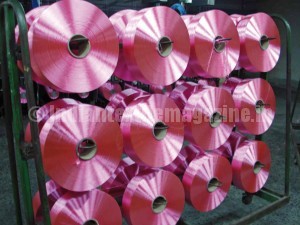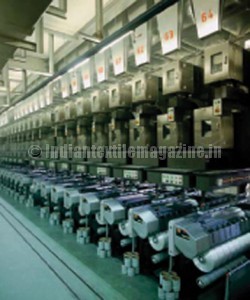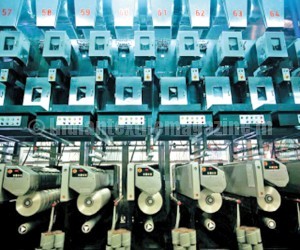Market expansion drive intensified

Reliance Industries Ltd. (RIL) demonstrated its ability to perform well in this challenging environment and enhanced its revenues by 9.2 per cent to Rs. 371,119 crores and profits by 4.8 per cent to Rs. 21,003 crores in 2002-03. RIL achieved record exports (15 per cent higher) at Rs. 239,226 crores as against Rs. 208,042 crores in FY 2011-12. Consolidated revenue from operations for the year ended March 31, 2013, was Rs. 397,062 crores, an increase of 10.8 per cent on a year-on-year basis.
RIL is the world’s largest polyester fibre and yarn producer with a capacity of around 2.4 MMT across nine sites in India and Malaysia. The company is undergoing capacity expansion across the polyester chain to strengthen its backward integration and provide affordable raw materials to the Indian textile industry.
The company’s Malaysian operations continued to develop new markets and enhanced its market presence in Korea and Indonesia by value-added product mix. Recron Malaysia commissioned a 100 KTA state-of-the-art PFY plant during the year.
With the planned addition of 1.5 MMT of polyester capacity at Silvassa and Dahej, RIL’s capacity, including Recron Malaysia, will be 3.9 MMT.
RIL’s total polyester production (PFY, PSF and PET) was 1.6 MMT in 2012-13, down by 2.1 per cent due to planned PFY facility turnaround. The company’s total fibre intermediates production (PX, PTA and MEG) in FY 2012-13 was at 4.7 MMT, largely steady as compared to the previous year.
RIL is the world’s fifth largest PX producer, the eighth largest MEG and the ninth largest PTA producer. Post expansions, the company will further strengthen its rank across the polyester chain.
RIL maintained its leadership position in the polymer industry with domestic market share of 41 per cent and commodity polymer production share of 62 per cent. RIL’s cracker operating rate was at 91 per cent. It produced 4.4 MMT of all polymers, including PP, PE and PVC and exported around 0.8 MMT during the year.
RIL, the world’s fifth largest PP producer, has 2.8 MMT installed capacity, with production facilities at Jamnagar, Hazira, Nagothane and Vadodara. In FY 2012-13, the company experienced a record PP production of 2,810 KT, up by three per cent in 2011-12.
The company continues to lead the domestic PP market with 64 per cent market share. India’s PP consumption for FY 2012-13 is estimated to be 3.1 MMT, growing at 13 per cent over FY 2011-12. The product is mainly used in manufacturing monofilaments, woven bags, appliances, houseware, flexible packaging, lamination film, textile and non-woven.
The new grades introduced into the market by RIL to counter imports include Repol SR70N heat sealable grade for food packaging application, a substitute for imported gradesl SRX100, with improved aesthetics, and Repol H050MN, modified for better draw-down and improved thermoforming characteristics.
Domestic demand for PE has grown by 10 per cent over the past year. Major end-uses of PE are containers, rigid packaging, lamination film, pouches, shrink films, career bags and pipes.
HDPE, LLDPE and LDPE demand have grown by 10 per cent, 13 per cent and 18.9 per cent Y-o-Y basis respectively. RIL has a total PE capacity of 1.1 MMT with production locations at Hazira, Nagothane, Vadodara and Dahej. The company has market shares of 18 per cent in HDPE, 37 per cent in LLDPE and 42 per cent in LDPE. It leads the domestic PE market with 28 per cent market share.
The company has increased its marketshare in high-value sectors in HDPE (like pipe, rotomolding and high flow). Besides, it has maintained its existing share in LDPE’s high-value sectors like milk packaging, extrusion coating and injection molding.

New growth initiatives
Reliance Industries helped create new markets by conducting and participating in 50 Rishta events throughout India. It also promoted the use of block bottom bags.
The company has been successful in attracting investments for 12 convertex lines for patented Adstar/Adpro bags production for cement packaging. This will address issues such as quality, aesthetic quotient in packaging, reduced labour availability in the labour-intensive raffia industry and others.
PP-made geotextile has immense potential in road construction and in river and sea embankment. Several States have specified its use in embankment projects.
During the year, RIL worked with the Textile Ministry and other agencies to facilitate new investments in geotextile. PP-nonwoven forms an ideal cover in banana plantations.
RIL has also tied up new projects with several agriculture institutes to establish PP in plantation of other fruits and vegetables. Besides increased production, it helps farmers grow high-quality products for the export market.
Subdued global demand
The global fibre and textile industry faced subdued demand in the consumer segment during the past year due to the volatile economic situation in the US and Europe and geo-political disturbances in Africa and the Middle East region. The overall global fibre consumption during FY 2012-13 reached 81 MMT, rising by three per cent over the previous year. Only Asian demand increased, while that for the rest of the world declined.
Polyester fibre and yarn continued to be the major contributor to the growth of fibre demand, increasing by seven per cent to 44 MMT. Demand largely increased in Asian countries, with China contributing nine per cent growth. Global polyester fibre and yarn capacity increased by 10 per cent, impacting operating rates, which declined to 78 per cent compared to 80 per cent in the previous year.
Prices during the year declined by 10-12 per cent from FY 2011-12 as buyers turned cautious given the slow downstream demand and chose to cut losses by controlling inventory.
Margins continued to be under pressure with polyester delta dropping 23-27 per cent to $166-240/MT. Over the past few years, the polyester industry enhanced the use of recycled polyester, derived from recycling PET bottles. Currently, over six MMT of clean flakes are produced from recycled PET waste. Among them, a major portion is used to manufacture recycled fibre, while the rest is used in sheeting and blow-moulding.

Polyester feedstock scenario
Feedstock markets, impacted by cautious market sentiments, experienced an overall price drop compared to FY 2011-12. PX prices remained largely stable, while those for PTA and MEG declined by nine per cent and 10 per cent respectively. PX witnessed a better year, with about two MMT lesser capacity additions than anticipated, keeping operating rates high at about 90 per cent. Demand was pegged at 33 MMT, rising three per cent from FY 2011-12. China witnessed 20 per cent demand increase due to downstream PTA capacity additions.
Planned capacity additions continued to impact the PTA markets. During the year, capacity grew by 12 per cent to 59 MMT. Demand, however, grew by five per cent to 50 MMT.
Overcapacity dented operating rates, which slipped to 83 per cent, compared to over 90 per cent in the past two years. China accounted for 85 per cent of the global capacity growth in the last two years, leaving little room for capacity expansion outside China.
Due to overcapacity in PTA and inadequate PX capacity build-up, PTA prices remained under pressure. Margins were consequently eroded and the FY 2012-13 average delta was below breakeven at $80/MT.
MEG markets witnessed no significant capacity additions during the year. High inventory at Chinese ports during the first half of the year lent some bearishness to prices, which recovered in the second half as inventory gradually reduced. Demand increased four per cent to 23 MMT during the year. China accounted for most of the demand increase. Operating rates were at 81 per cent, the best in past five years.
Delta over naphtha declined 18 per cent to $429/MT, largely due to the slack downstream demand. However the margins continued to remain above the long-term average.
Cotton production
Global cotton production in the 2012-13 cotton year surpassed consumption, leading to closing stocks reaching a historical high. Record Chinese strategic cotton reserve procurement helped stabilise both Chinese and global cotton prices. Moreover, procurement prices fixed by China Reserve were substantially higher than the international rates, putting pressure on the competitiveness of the Chinese spinners.
By the end of the 2012-13 cotton season, China is estimated to have about 10 MMT closing stock which translates to over 50 per cent of the global stocks and almost an year’s Chinese domestic consumption.

Developments in the Indian market
Cotton and polyester are the major raw materials for India’s textile industry. Together they account for around 90 per cent of Indian textile mill consumption of all fibres. India’s per capita fibre consumption is around 5 kg, almost half the global level. Polyester is likely to play a dominant role in capturing the major incremental demand share to bridge this gap.
Domestic prices of polyester and cotton witnessed less volatility during the year as compared to that in cotton prices last year. This improved the profitability and viability of the downstream textile industry. However, continued power shortage in key downstream textile and packaging manufacturing centres, especially in southern India, limited polyester demand growth.
Downstream polyester demand remained depressed earlier in the year, amidst subdued global markets, due to high polyester inventories, lower margins and steep decline in feedstock prices. Domestic demand improved in the second half of the year. Also, delayed monsoon in India led to healthy demand for PET from the water and beverage segments.
During FY 2012-13, domestic polyester demand grew by 5.1 per cent, led by 10 per cent growth from PET and 4.4 per cent growth from PSF. In the PFY segment, FDY witnessed a growth rate of 10 per cent over last year.
PFY, PSF and PET demand was around 2.3 MMT, 0.82 MMT and 0.57 MMT, of which RIL’s share was around 24 per cent, 68 per cent and 46 per cent respectively. In case of feedstock, PTA demand was at four MMT, up by 10 per cent, amidst the incremental demand on start-up of new polyester capacities in the country. MEG demand is estimated at 1.7 MMT, up by seven per cent. PX demand is estimated at 2.3 MMT, up by five per cent.
Outlook
Global textile fibre industry is expected to grow 24 MMT by 2020 to 105 MMT. Of this polyester will account for over 68 per cent of global demand growth. India is poised to strengthen its global foothold with its polyester production share rising to 10 per cent of global volume from the current eight per cent.
The global PET industry is likely to witness capacity growth of 10 MMT by 2015 to about 32 MMT. With supplies likely to remain above incremental demand, utilisation rates are expected to remain under pressure in the medium term.
For feedstock, tight PX market conditions are likely to continue till 2014 until planned capacity additions are executed. The year 2015 would witness PX capacity growth of 12 MMT over 2012. Operating rates are expected to be maintained above 80 per cent. PTA markets will continue to witness oversupply, with excess capacities likely to make China self-sufficient in the next two years.
China is likely to emerge as a major influence in the global MEG markets by 2015 with 85 per cent of global MEG expansions. Any issue in the operational success of MEG manufactured from the planned coal-based DMO process would lead to product shortage and impact prices.
India’s all-fibre textile mill consumption is likely to grow at a 5.2 per cent CAGR between 2012 and 2020 to 12.3 MMT.
The CAGR growth in demand for PFY and PSF is expected to be 8.6 per cent and 5.4 per cent respectively. Polyester is likely to account for a major 60 per cent of incremental domestic fibre demand between 2012 and 2020.
As per Technopak projections, India’s total textile and apparel market size (domestic and export), estimated at $89 billion in 2011, is projected to grow at a nine per cent CAGR to reach $223 billion by 2021.
The domestic textile and apparel market size was $58 billion in 2011 and is projected to grow to $141 billion by 2021. The key growth segments are technical textiles which is likely to see a 10 per cent CAGR, followed by nine per cent in apparels and eight per cent in home textiles.
Polyester chain project update
Reliance has embarked upon a major polyester chain expansion to take full advantage of the feedstock integration and the domestic growth opportunity. These include setting up of a world-scale 1.8 MMTPA of PX plant, doubling the PTA capacity to 4.3 MMTPA and expanding the polyester portfolio by 1.5 MMTPA.
Implementation of all these projects have begun in full swing and are expected to see production from the newly commissioned projects in phases over the next two-three years.
Indian polymer market
Despite being among the fastest growth markets globally, India’s per capita plastic consumption (PE, PP and PVC) at 6.6 kg remains far behind those of the US (67.3 kg), China (36.7 kg) and Brazil (24.6 kg). However, it is advancing at 2.5 times its GDP growth. Besides, the sub-continent’s surging industrialisation and increasingly powerful economy holds immense untapped growth potential.
Global automobiles, electronics, telecommunications, food processing, packing and healthcare companies have established large manufacturing bases in India. Joint ventures, foreign investments and access to technology from developed countries have opened new vistas to further facilitate growth of the industry.
Infrastructure investments have ensured more than 10 per cent growth rate for the sector. Moreover, the agricultural sector’s focus on plasti-culture under the micro-irrigation scheme will further boost demand.
India’s manufacturing capacity of polymer products is estimated to reach 12 MMTPA in 2017, from 8.3 MMTPA in 2012.
Polymer consumption in India is poised to grow multifold, with the help of new developments in packaging applications, infrastructure growth, modernisation of the agriculture sector, expanding healthcare facilities, and improved lifestyle and disposable incomes, automobile demand and rural penetration.
Polymer packaging product development has revolutionised Indian lives. India’s packaging polymer consumption, accounting for over 60 per cent of total polymers consumed, reached 5.5 MMT in 2012 and is expected to reach 10 MMT by 2020. The key growth drivers for this sector are foods and processed food items, FMCG and cosmetics.